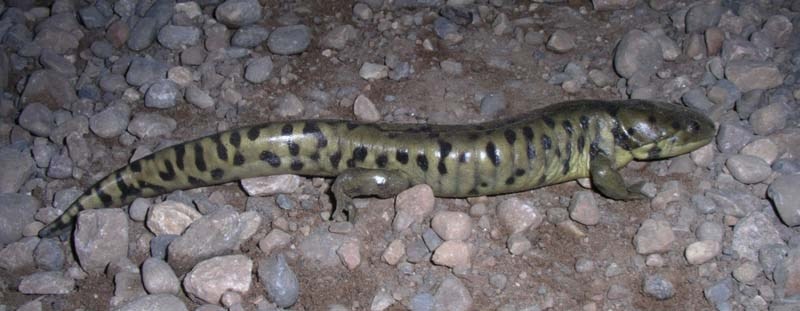If the pike is the shark of the Sturgeon River, then the tiger salamander must surely be its Godzilla. Up to 25 centimetres long, these massive, all-terrain creatures rule the land and the seas, and can easily devour lesser creatures.
If the pike is the shark of the Sturgeon River, then the tiger salamander must surely be its Godzilla.
Up to 25 centimetres long, these massive, all-terrain creatures rule the land and the seas, and can easily devour lesser creatures. They're fairly common, and are likely the biggest creatures of their kind on the continent.
Yet you're unlikely to see one unless you're lucky.
“They're pretty hard to find,” says Kris Kendell of the Alberta Conservation Association, even for biologists like him who study amphibians. Salamanders spend much of their time underground or under cover during the day, making them very tough for the casual observer to spot.
“Most people don't see these guys.”
Robert MacDonald of Wildlife Control Services spotted one of the great beasts swimming up Whitemud Creek near Fort Edmonton Park recently and grabbed it for a quick photo-op.
“Very mobile,” he says of the creature, and very quick to jump out of your hands. “Nothing stiff about him.”
The tiger salamander is considered the biggest land-dwelling salamander in North America, Kendell says. As adults, they look like big lizards, having four equally long legs, a long, alligator-like tail and smooth, moist skin.
“Some people will say they feel like a frog but look like a lizard.”
The tiger salamander gets its name from the bold black bars and blotches that it has over its skin, which is typically yellow-white, reports Alberta Fish and Wildlife. Older ones may look more brown or olive.
Kendell says the tiger salamander is one of only two salamanders found in Alberta, the other being the long-toed salamander. The long-toed salamander has a bold yellow stripe down its back and is found only in mountainous areas, whereas the tiger roams throughout most of central and southern Alberta.
Tiger salamanders are a part of the mole salamander family and spend most of their time underground, Kendell says. While this usually means burrows such as those left by pocket gophers, it can also mean the moist, loose dirt of a garden – probably the best spot to find these giants. They also sometimes get stuck in window wells.
MacDonald says he usually finds tiger salamanders along streams or under clumps of wet vegetation. Watch carefully, and you can sometimes see them along gravel roads.
Tiger salamanders use their speed and short, sticky tongues to eat fish, frogs, mice, worms, other salamanders … pretty much anything they can fit in their big, frog-like mouths.
“They're very voracious eaters,” MacDonald says.
This is mating season for tiger salamanders, so you're likely to find them around ponds and wetlands, Fish and Wildlife reports. Don't expect to hear them, though – unlike frogs, salamanders do not call and are very, very quiet.
Males will have burrowed their way to the surface to breed sometime in April and meet with females around a local water body. The males put down sperm packets (spermatophores) that the females grab to fertilize their eggs. Once laid, their small, short strings of eggs hatch into larvae in about 10 days.
Salamander larvae are bizarre, alien-looking creatures with legs, a broad tail fin and big feathery gills on the sides of their heads – picture an axolotl if it helps.
Some will never grow up, becoming sexually mature as larvae. These neotenous salamanders keep their gills and tail fins and may become even bigger than regular ones. Excellent water and poor land conditions often cause this state to occur, Kendell says.
Like most amphibians, tiger salamanders are sensitive to pollution, making them an early warning sign for the health of the environment, MacDonald says.
“If you're starting to lack amphibians, you've got to wonder why.”
Kendell says it's important to preserve wetlands to help the tiger salamander, as they use those wet areas to breed. Pocket gophers can also provide significant habitat.
If you find one of these mini-Godzillas stomping around in your garden, MacDonald suggests you enjoy the sight of it.
“I know he's eating the bugs that are going to be eating my plants.”
Tiger salamander
Name:<br />Ambystoma tigrinum.<br /><br />Appearance:<br />Big lizard-like creature with smooth skin and black, dark brown or green stripes. Sometimes yellow, sometimes green or brown – colour varies wildly across North America.<br /><br />Commonly seen:<br />In your garden, along gravel roads, very, very rarely. <br /><br />Occasionally confused with: <br />The long-toed salamander, which has a vivid yellow stripe along its back. <br /><br />Fun fact:<br />During courtship, males may impersonate females to sneak in and deposit their sperm packet atop a rival's. The female then picks up the impersonator's sperm, none the wiser.
Wild St. Albert
Like wildlife? So do we! Every second Wednesday the Gazette profiles a reasonably common wild creature in the St. Albert region. Birds, beasts, bugs, fish … so long as it's alive and kicking, we'll feature it. <br /><br />Got a creature you'd like to see profiled? Send your suggestions to [email protected].




